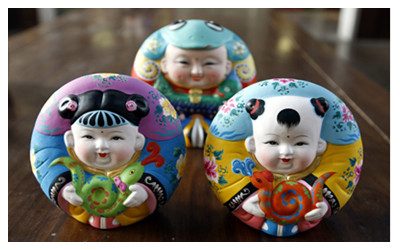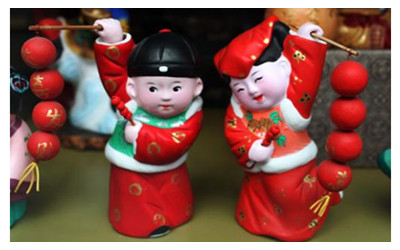- Home
- Travel In China > China Culture > Chinese Handicrafts >
Chinese Clay Sculpture

Chinese Clay Sculpture, a kind of folk craft of sculpturing a variety of figures from clay, is also known as “painted sculpture” and “mud play”. Clay sculpture art is an ancient and common Chinese folk art form in which clay can be used as raw material and kneaded by hand to take form. They are plain in color or multi colored and mainly take the shape of human figures and animals. Such, Beijing Clay Sculpture is known for its simple, unrefined and pleasant style.
History of Chinese Clay Sculpture
Chinese clay sculpture art can be traced back to the Neolithic period – 4,000 to 10,000 years ago. There have been many archaeological findings of protoculture: the ceramic pig and ceramic sheep unearthed from the Hemudu Cultural Relics in Zhejiang date back about 6,000 or 7,000 years. The ancient ceramic well, clay pig and clay sheep head sculptures unearthed from Peiligang Cultural Relics in Xinzheng, Henan date back 7,000 years. These artifacts have been verified to be works of art kneaded by early human hands.
Since the end of the New Stone Age, Chinese clay sculpture art production has been uninterrupted. In the Han Dynasty, it became an important art form. Archaeologists have excavated a large amount of cultural relics from the tombs of two Han Dynasties. The number of pottery figurines, pottery animal, pottery carriages and pottery ships etc. found has been extensive. Some examples were kneaded by hand and some were mold produced. The ancients of the Han Dynasty believed that people in the afterlife also led the lives of living people and also bore the demands of material life. A large number of funeral objects were required by mortuary customs, objectively promoting the development and evolution of clay sculpture.

After the two Han Dynasties, with the rise of Taoism and the introduction of Buddhism as well as the enshrinement activities of polytheism, Taoist temples, Buddhist temples and temples across society sprang up, directly promoting the demand of clay Buddha sculptures and for the development of clay sculpture. In the Tang Dynasty, clay sculptures were at their peak. Yang Huizhi, was honored as a divine sculptor was an outstanding representative during the Tang Dynasty. He and Wu Daozi both learnt with Zhang Sengyao. Daozi finished his study and Huizhi was unwilling to lag behind. He resolutely burnt his writing brushes and ink stones and worked hard to learn sculpture and finally he became a famous master who was praised by the common people: “Daozi’s painting and Huizhi’s sculpture have inherited the essence of Sengyao”.
When the clay sculpture art developed to the Song Dynasty, the large figure of Buddha continued to be prevalent and small clay toy sculptures were also developed. Many people were specially engaged in the production of clay figurines and sold them as commodity. In the Northern Song Dynasty, the famous clay toy “Grinding Drinking Music” from Dongjing (the capital of Northern Song Dynasty) was on sale around the 7th date of the 7th lunar month. Common people bought it as a “begging opportunity”. In addition, the high officials and noble lords also bought it for shrines and to worship as well as for play during the seventh evening of the seventh moon.
After the Yuan Dynasty, clay sculpture works of art continued their unabated spread across society throughout the Ming Dynasty, the Qing Dynasty and the period of the Republic of China, especially small clay sculptures which can be appreciated, displayed and be played with by children. The sculptures were produced all over the country and famous production areas include Huishan, Wuxi, Tianjin (Clay Figure Zhang), Fengxiang, Shanxi, Baigou, Hebei, Gaomi, Shandong, Junxian, Henan, Huaiyang and Beijing.
Features of Chinese Clay Sculptures
Clay sculpture art is a kind of Chinese folk art. The folk artisans use natural or cheap materials but can make small and exquisite artifacts, gaining popularity with common people. Though clay sculptures are not technologically involved, they bring highlights to people’s lives by means of simplicity, direct-vision, authenticity and hands on characteristics.
In terms of collection times, clay sculpture collections are very challenging and collections are valued. Each work is made by hand and is unique and is artistically untainted by copies, reproductions or counterfeits etc. Different from, other forms of art such as paintings, paper cuttings and embossment etc., clay sculpture art has a strong visual impact with appreciation from varying angles adding richness and diversity, more closely resembling life.
Famous Clay Sculpture in China
Clay Figurin Zhang, the folk culture of Tianjin, is one of the well-known traditional handcrafts in China. It has been regarded as the treasure of Chinese culture. As a school of widespread folk painted sculpture in Northern China, clay figurin Zhang created by artist Zhang Mingshan in Tianjin is the first group of nation-class Intangible Cultural Heritage.
Huishan Clay Figurine , one of the three most famous special local products, is a traditional crafts of
Han natio
Today, with high technology developing rapidly, reflection upon this art form allows people to return to an original simplicity and clay sculptures allow for a manifestation of fashion and individuality.
China attaches great importance to the protection of intangible cultural heritage. On May 20th, 2006, upon the approval of the State Council, clay sculpture was listed in the first batch of national intangible cultural heritage.

 Chinese Clay Sculpture, a kind of folk craft of sculpturing a variety of figures from clay, is also known as “painted sculpture” and “mud play”. Clay sculpture art is an ancient and common Chinese folk art form in which clay can be used as raw material and kneaded by hand to take form. They are plain in color or multi colored and mainly take the shape of human figures and animals. Such, Beijing Clay Sculpture is known for its simple, unrefined and pleasant style.
Chinese Clay Sculpture, a kind of folk craft of sculpturing a variety of figures from clay, is also known as “painted sculpture” and “mud play”. Clay sculpture art is an ancient and common Chinese folk art form in which clay can be used as raw material and kneaded by hand to take form. They are plain in color or multi colored and mainly take the shape of human figures and animals. Such, Beijing Clay Sculpture is known for its simple, unrefined and pleasant style. After the two Han Dynasties, with the rise of Taoism and the introduction of Buddhism as well as the enshrinement activities of polytheism, Taoist temples, Buddhist temples and temples across society sprang up, directly promoting the demand of clay Buddha sculptures and for the development of clay sculpture. In the Tang Dynasty, clay sculptures were at their peak. Yang Huizhi, was honored as a divine sculptor was an outstanding representative during the Tang Dynasty. He and Wu Daozi both learnt with Zhang Sengyao. Daozi finished his study and Huizhi was unwilling to lag behind. He resolutely burnt his writing brushes and ink stones and worked hard to learn sculpture and finally he became a famous master who was praised by the common people: “Daozi’s painting and Huizhi’s sculpture have inherited the essence of Sengyao”.
After the two Han Dynasties, with the rise of Taoism and the introduction of Buddhism as well as the enshrinement activities of polytheism, Taoist temples, Buddhist temples and temples across society sprang up, directly promoting the demand of clay Buddha sculptures and for the development of clay sculpture. In the Tang Dynasty, clay sculptures were at their peak. Yang Huizhi, was honored as a divine sculptor was an outstanding representative during the Tang Dynasty. He and Wu Daozi both learnt with Zhang Sengyao. Daozi finished his study and Huizhi was unwilling to lag behind. He resolutely burnt his writing brushes and ink stones and worked hard to learn sculpture and finally he became a famous master who was praised by the common people: “Daozi’s painting and Huizhi’s sculpture have inherited the essence of Sengyao”. Ask Questions ?
Ask Questions ?